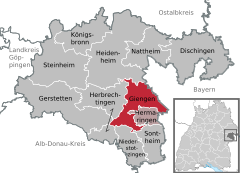
Back Giengen an der Brenz ALS غينغن آن در برنتس Arabic قینقن آن در برنتس AZB Гинген ан дер Бренц Bulgarian Бренц-тӀера-Гинген CE Giengen an der Brenz (munisipyo) CEB Giengen an der Brenz Danish Giengen an der Brenz German Giengen an der Brenz Esperanto Giengen an der Brenz Basque
This article needs additional citations for verification. (December 2021) |
Giengen | |
|---|---|
 Giengen from the Bruckersberg | |
Location of Giengen within Heidenheim district  | |
| Coordinates: 48°37′18″N 10°14′42″E / 48.62167°N 10.24500°E | |
| Country | Germany |
| State | Baden-Württemberg |
| Admin. region | Stuttgart |
| District | Heidenheim |
| Subdivisions | 5 |
| Government | |
| • Lord mayor (2017–25) | Dieter Henle[1] (Ind.) |
| Area | |
| • Total | 44.05 km2 (17.01 sq mi) |
| Elevation | 464 m (1,522 ft) |
| Population (2022-12-31)[2] | |
| • Total | 20,133 |
| • Density | 460/km2 (1,200/sq mi) |
| Time zone | UTC+01:00 (CET) |
| • Summer (DST) | UTC+02:00 (CEST) |
| Postal codes | 89537 |
| Dialling codes | 07322 |
| Vehicle registration | HDH |
| Website | (in English) |
Giengen (German pronunciation: [ˈɡɪŋən] ; full name: Giengen an der Brenz; Swabian: Gẽänge) is a former Free Imperial City in eastern Baden-Württemberg near the border with Bavaria in southern Germany. The town is located in the district of Heidenheim at the eastern edge of the Swabian Alb, about 30 kilometers northeast of Ulm on the Brenz River.
Giengen is the hometown of the Margarete Steiff corporation, who invented the teddy bear.
Positioned on the Nuremberg-Ulm-Constance route, one of the main feeder routes of the Compostella Trail, Giengen is visited each year by an increasing number of walking pilgrims on their way to Santiago de Compostella.
- ^ Aktuelle Wahlergebnisse, Staatsanzeiger, accessed 12 September 2021.
- ^ "Bevölkerung nach Nationalität und Geschlecht am 31. Dezember 2022" [Population by nationality and sex as of December 31, 2022] (CSV) (in German). Statistisches Landesamt Baden-Württemberg. June 2023.


